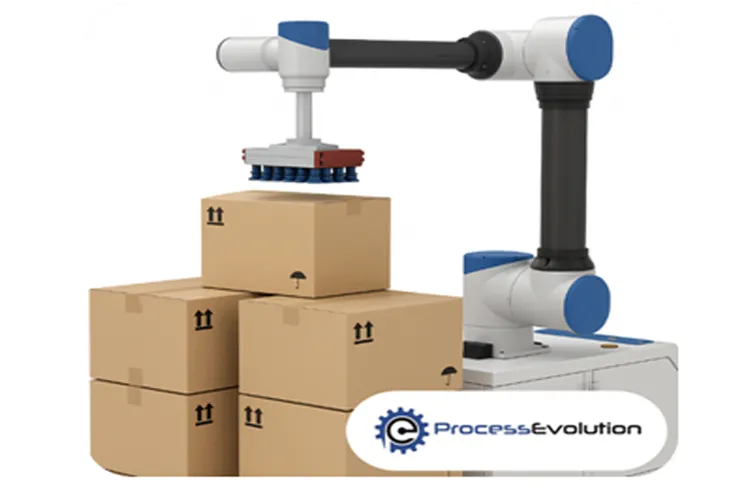
The Future of Robotic Palletising in Australia
What Is Robotic Palletising and Why It Matters
From Manual Handling to Automation
Robotic palletising refers to the process of automatically stacking products—such as cartons, pails, or boxes—onto pallets using industrial robots or collaborative robots (cobots). Once considered technology reserved for large factories, robotic palletising is now transforming operations across small to medium-sized manufacturers throughout Australia.
Manual palletising has long been a bottleneck in production. It’s physically demanding, repetitive, and a common cause of workplace injuries. With growing labour shortages and rising costs, more manufacturers are recognising the value of automation to improve productivity, safety, and consistency.
How Robotic Palletising Improves Efficiency and Safety
Robotic palletisers provide a safer, faster, and more consistent way to move finished products from production lines onto pallets. They work tirelessly, operate at precise speeds, and deliver perfectly stacked loads every time.
By integrating robotic palletising into production lines, manufacturers can achieve:
• Higher throughput with predictable output rates.
• Reduced labour dependency in physically demanding roles.
• Improved pallet quality, reducing transport damage and rework.
• Better operator safety by removing repetitive lifting tasks.
The Australian Manufacturing Landscape and the Shift to Automation
Local Challenges Driving Automation Adoption
Australian manufacturers face a unique combination of challenges: high labour costs, skill shortages, and increasing demand for shorter production runs and multi-SKU flexibility. Many are now turning to robotic palletising as an accessible first step into factory automation.
By automating end-of-line palletising, businesses free up skilled staff for higher-value tasks while reducing fatigue, errors, and downtime. It’s a practical and immediate way to improve efficiency without overhauling entire production lines.
Why Local Design and Support Matter for Long-Term ROI
When investing in automation, after-sales support and local expertise make all the difference.
At Process Evolution, we design and build our robotic palletising solutions locally in Australia, ensuring that every system is engineered to Australian standards and tailored to specific site requirements.
Local build means:
• Faster turnaround times from concept to commissioning.
• Readily available support, spare parts, and service engineers.
• Systems designed for Australian environments and compliance.
This local capability ensures not just faster ROI but also long-term reliability and performance.
Comparing the Three Main Types of Robotic Palletising Systems
Bespoke Industrial Robotic Palletising Cells
Industrial robotic palletising cells are custom-engineered systems built around high-speed six-axis robots. These systems are ideal for dedicated high-throughput lines and can include pallet dispensers, automatic wrapping, stretch-wrapping, and labelling.
They offer maximum speed and payload capacity, often palletising multiple products or pallets simultaneously. For manufacturers producing at scale, these bespoke systems provide unmatched output and can be fully integrated with upstream packaging and conveying systems.
However, industrial palletisers typically require more floor space and higher initial investment, making them better suited for large, stable production lines rather than frequent changeovers.
Flexible Cobot Palletising Systems
Cobot palletisers use collaborative robots designed to safely work alongside people without the need for extensive guarding. They’re ideal for facilities handling multiple SKUs, shorter runs, or frequent product changes.
These systems are easy to program, energy-efficient, and can be redeployed across lines, offering exceptional flexibility. Cobots have a lower payload and slower speed compared to industrial robots, but they’re perfectly suited to small and medium-sized manufacturers seeking an affordable entry point into robotic automation.
At Process Evolution, we integrate cobot palletisers that can be configured for dual-pallet operation, variable stacking patterns, and different carton sizes—all controlled via intuitive HMI interfaces.
Dedicated Cobot-Style Palletising Machines (Like the AWP Model)
A new generation of dedicated palletising machines, like our AWP palletiser, bridges the gap between cobots and traditional industrial robots.
These systems are purpose-built for palletising, combining cobot-style flexibility with industrial-grade rigidity, speed, and payload capacity. Unlike generic cobots, the AWP model uses integrated servo drives, advanced motion control, and a compact footprint, making it ideal for repeatable palletising operations with consistent product sizes.
They deliver the reliability of an industrial robot and the ease of use of a cobot, offering Australian manufacturers the best of both worlds.
Choosing the Right Palletising Solution for Your Facility
Throughput, Product Mix, and Footprint Considerations
Selecting the right system depends on factors such as throughput rate, number of SKUs, available floor space, and level of automation in surrounding processes.
• High-volume, single-SKU operations benefit from bespoke industrial palletisers.
• Multi-SKU or smaller batch operations often find greater value in cobot or AWP systems.
Integration with Case Erect and Pack Lines
When integrated with case erect and pack solutions, robotic palletising provides a fully automated end-of-line packaging solution. Process Evolution’s systems can manage everything from product collation and boxing to palletising and stretch-wrapping, reducing manual handling and streamlining the packaging flow.
The Role of ROI and Payback Period in Decision Making
ROI on robotic palletising systems can often be achieved in 6–12 months, especially in multi-shift operations. Labour savings, improved efficiency, reduced injury risk, and fewer production stoppages all contribute to rapid payback.
Process Evolution works closely with clients to calculate ROI projections, factoring in site-specific data such as current labour cost, downtime, and production rate improvements.
Why Australian Manufacturers Are Turning to Local Expertise
Customised Solutions Built for Australian Standards and Conditions
Each Process Evolution palletising system is engineered and built locally, ensuring full compliance with AS/NZS 4024 safety standards and designed for local environmental conditions.
We understand Australian manufacturing challenges—from space constraints to temperature variations—and build machines that perform reliably year after year.
On-the-Ground Support and Faster Response Times
Our clients enjoy direct access to local engineers for installation, commissioning, and support. There’s no waiting for overseas technicians or dealing with time-zone delays. We provide genuine, long-term partnerships, ensuring uptime and confidence in every system we deliver.
Future-Proofing Through Scalable, Locally Engineered Systems
Process Evolution designs systems with scalability in mind. Whether adding a second pallet station, upgrading grippers for new SKUs, or integrating vision systems for barcode tracking, our solutions evolve with your production needs.
The Road Ahead for Robotic Palletising
Emerging Trends in Automation and Smart Manufacturing
Australia’s manufacturing sector is entering a new era of smart automation. Robotic palletising systems are now integrating with factory data networks, predictive maintenance dashboards, and AI-driven vision systems to monitor performance and quality in real time.
Sustainability and Labour Optimisation Through Robotics
By improving energy efficiency and reducing waste from product damage, robotic palletising supports sustainable manufacturing goals. It also helps address labour shortages by reassigning operators to roles that add more value to the business.
How Process Evolution Is Shaping the Future of Robotic Palletising in Australia
At Process Evolution, we’re proud to lead the way in locally designed and supported robotic palletising solutions. From flexible cobot palletisers to high-speed industrial cells and dedicated systems like our AWP palletiser, we help Australian manufacturers embrace automation with confidence.
Conclusion: Partnering for a Smarter, Safer, and More Efficient Future
As automation continues to reshape the industry, robotic palletising will remain a cornerstone of efficient, modern manufacturing in Australia.
Whether you’re seeking a bespoke industrial palletising system or a compact cobot solution, Process Evolution has the local knowledge, engineering expertise, and ongoing support to make it a success.
Ready to explore robotic palletising for your production line?
Speak to Process Evolution today to discuss your automation goals and see how we can help you achieve faster ROI, safer workplaces, and future-ready performance.

